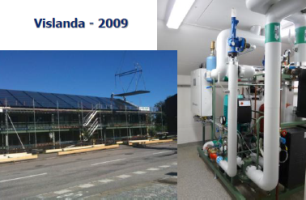Sweden: Growing Number of Feed-in Contracts with District Heating Providers
December 20, 2010
 Net metering solar heat: Allbohus Fastighets AB, a municipal housing company, has built a roof-integrated solar collector field of 350 m2 on a multi-family building in Vislanda, Sweden, which is connected to the district heating network via a pre-fabricated sub-station. When the solar heat is greater than the building’s heat load, the building owner will be paid for the solar heat going into the heating network. When the solar energy does not cover the building’s heating demand, the building owner pays for the complementary heat delivered by the heating network.
Net metering solar heat: Allbohus Fastighets AB, a municipal housing company, has built a roof-integrated solar collector field of 350 m2 on a multi-family building in Vislanda, Sweden, which is connected to the district heating network via a pre-fabricated sub-station. When the solar heat is greater than the building’s heat load, the building owner will be paid for the solar heat going into the heating network. When the solar energy does not cover the building’s heating demand, the building owner pays for the complementary heat delivered by the heating network.
Photo: Heat-On
“An increasing number of building owners connected to district heating have expressed an interest to use solar collectors on their buildings,” Jan-Olof Dalenbäck, professor at Chalmers University of Technology and project manager of Swedish planning and consulting firm CIT Energy Management AB, said during his presentation at the solar conference “Forum Solarpraxis” in Berlin, Germany, in November. A technically adequate solution for them is to connect the solar collector field with a district heating’s main circuit, using the district heating system as a buffer storage and establishing a net metering contract with the district heating provider (see the following figure). 80 % of the district heating price of about 0.07 EUR/kWh is usually paid for excess kilowatt-hours fed into the district heating network.
An important construction detail for a successfully running net metering system is the pre-fabricated solar district heating sub-station, including heat exchanger, expansion, pumps and controls by Swedish company Armatec.
 Decentralised solar heating plant: The energy from the collector field on the roof of the building can either be used to cover the heating demand of the building or it can be fed into the district heating network.
Decentralised solar heating plant: The energy from the collector field on the roof of the building can either be used to cover the heating demand of the building or it can be fed into the district heating network.
Figure: Chalmers University of Technology
The advantages of the system: The collector field can be designed based on available space on the roof and dimensions of the district heating branch on site, and not on the actual load of the specific building. Second: The solar heat can be put to optimal use without overheating in summer. Third: A third party investment is possible, too. The solar investment can be made by the housing facility owner, by a specific plant owner (ESCO) or the utility.
According to Dalenbäck, several collector systems in Sweden and Austria have already been used as net metering systems. In this context, the Swedish researcher also referred to a report drafted in the framework of the European project “Solar District Heating”, which will be published later in January.
More information:
CIT Energy Management AG: http://www.energy-management.se/
EU-project Solar District Heating: http://www.solar-district-heating.eu
Armatec: http://www.armatec.se


